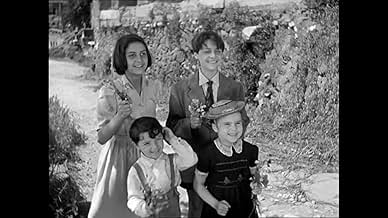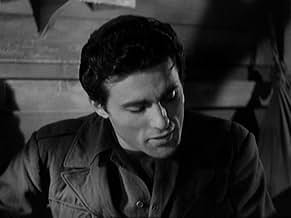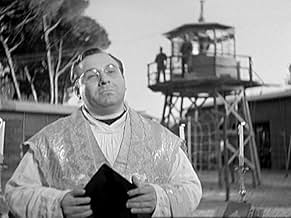Füge eine Handlung in deiner Sprache hinzuAfter WW2, a group of Italian soldiers languishing in a California POW camp is nostalgically reminiscing about the happy pre-war years while awaiting repatriation.After WW2, a group of Italian soldiers languishing in a California POW camp is nostalgically reminiscing about the happy pre-war years while awaiting repatriation.After WW2, a group of Italian soldiers languishing in a California POW camp is nostalgically reminiscing about the happy pre-war years while awaiting repatriation.
Olga Villi
- Mirella
- (as Olga Villy)
Empfohlene Bewertungen
NATALE A CAMPO 119 (CHRISTMAS AT CAMP119) was released in the United States under the title ESCAPE INTO DREAMS. It is, in fact, about the dreams of home that Italian prisoners of war have in a P.O.W. camp in California after the war has ended and the ex-soldiers are awaiting release. The cast reads like a who's-who of some of the best Italian actors and actresses of that period: Vittorio De Sica, Peppino De Filippo, Massimo Girotti, Aldo Fabrizi, Maria Mercader, Vera Carmi, Ave Ninchi. The gifts of radioed voices of families back home and recordings of Italian popular songs conjure up the memories that we see in flashback. They are comic or bittersweet little vignettes with backgrounds of major tourist sights as a kind of visual obbligato. Aldo Fabrizi is seen taking his five little kids through Rome and trying to keep them at a distance as he foolishly flirts with young Vera Carmi on the Aventine Hill. In the Naples "dream" Vittorio De Sica is a nobleman gambler trying to dodge his creditors. His character is similar to that of his role in the episode of "The Gambler" in his THE GOLD OF NAPLES and is similar to his real-life persona as well. With his crafty chauffer Peppino De Filippo, he makes a getaway in a hearse. In the Florence recollection Aldo Fiorello's lover Maria Mercader is seen trying to arrange a proxy marriage with an old museum guard Adolfo Mancini to legitimatize the child, a little boy she has had by Aldo after he went away. The Milan and Sicily dreams are short undeveloped bits of nostalgia. In the Venice episode we see gondoliere Massimo Girotti falling for a Norwegian tourist, Olga Villi, who inevitably and humiliatingly ditches him. Connecting all the memories are the scenes in the camp itself, a kind of minor-key STALAG 17 ambience, with an American sergeant played by a miscast Adolfo Celi in a manner that can only be called laughable and ludicrous. It is one of the few unconvincing bits in an otherwise appealing and humane movie directed by Pietro Francisci. Its implied message, aimed at Italian citizens across the political and regional spectrum at a moment of divisive postwar national political turmoil, was that "We may all have different ways of speaking, and have different local customs, but we are all Italians. We are one nation." One could think of no better message at Christmas time.
The film stands as a quietly complex artifact of postwar Italian cinema, a moment when the country was not only reconstructing its cities but also reassembling the fragments of its cultural and national identity. Emerging just two years after the end of the war, the movie does not offer a triumphalist or accusatory gaze, but instead takes a modest, humane approach to the experience of Italian prisoners of war in an Allied detention camp. It is this specificity-men removed from direct combat, caught between defeat and repatriation-that gives the film its unusual emotional texture: one that privileges irony, memory, and resilience over spectacle or martyrdom.
Visually, the film remains deliberately restrained. The mise-en-scène is spare but rich in details that evoke both the austerity of captivity and the resourcefulness of the prisoners. Set almost entirely within the confines of the camp, the direction emphasizes the monotony of waiting, of routines born out of necessity, and of the quiet dignity extracted from the banality of day-to-day survival. The camera often opts for middle-distance compositions and long takes that allow for a kind of theatrical fluidity; characters move in and out of frame with a naturalistic ease that mirrors the cyclical nature of camp life. The editing avoids flourish, maintaining a rhythm that feels less like narrative propulsion than like suspended time-a state of semi-permanent waiting that reflects the historical limbo of the immediate postwar period.
The sound design, and especially the use of music, constitutes one of the film's most powerful and intricately woven elements. Music here is not a decorative addition, nor merely illustrative. It is a central narrative and expressive device-perhaps even a character of its own. The film constructs an acoustic landscape that traces the cultural diversity of Italy through song, accent, rhythm, and popular memory. It becomes a musical journey across the regions of a fractured nation, expressed through the voices of men who, far from home and stripped of political certainty, cling to what can still be sung, remembered, or collectively reimagined. The camp, as a physical prison, is countered by this sonic reconstitution of Italy-each dialectal variation, folk melody, or improvised performance a reaffirmation of identity and emotional rootedness.
These musical sequences are carefully staged, not as distractions from the dramatic flow but as structural supports for it. They serve to rhythmize the narrative, punctuating the everyday monotony of captivity with bursts of cultural life that are as performative as they are intimate. The characters do not merely sing; they reenact, they mourn, they laugh, they remember through music. The film thus offers an unusually rich example of how sound and image can coalesce into a form of storytelling that is both sensorial and ideological. Particularly in the scenes involving the Christmas performance, music becomes a metaphor for resilience, not in a simplistic or heroic sense, but as a form of presence-the persistence of language, region, and history in the face of enforced uniformity.
This approach has a deep emotional resonance. At a time when the idea of Italy as a unified nation was under critical scrutiny-politically, socially, and culturally-the film articulates a possible answer: unity not imposed by ideology, but found in shared expression, in cultural memory and artistic ritual. The voice becomes more than sound; it becomes home.
The performances reflect this tonal balance exquisitely. There is a sense of familiarity and trust among the ensemble, a chemistry that suggests shared history more than scripted interaction. The humor is never forced; it rises organically from the rhythms of group dynamics, from the small absurdities of military discipline and the improvisations of daily life under constraint. What emerges is not a gallery of war archetypes, but a mosaic of individuals whose personalities are shaped as much by regional identity and personal quirks as by the experience of captivity. Even in its moments of levity, the acting remains grounded in emotional truth. The theatrical backgrounds of much of the cast lend the performances a physicality and timing well-suited to the film's confined spaces and episodic structure.
One of the film's more compelling formal qualities is its treatment of space and performance. The construction of the camp as both prison and stage-literalized in the Christmas play-allows for a layered meditation on identity. The prisoners perform for each other, but also for themselves, for memory, and perhaps for a homeland that now exists more in imagination than in geography. These moments are not framed with irony, but with a kind of gentle solemnity. They reveal a belief in art-not as transcendence, but as persistence. In this, the film shares affinities with The Wooden Horse (1950), which similarly explores how creative labor becomes a substitute for physical escape. However, where that British film moves towards the teleology of breakout and victory, this one dwells in the space between hope and endurance. The theatrical and musical elements are not means to an end, but ends in themselves: ways to survive time, to remain human.
Cinematographically, there is a clear economy of means that reflects both budgetary constraints and artistic intention. Lighting is soft, sometimes flat, but always attuned to the realism of the setting. In scenes of musical performance or group interaction, the camera wisely refrains from over-staging; it watches rather than directs, allowing the emotional currents of the ensemble to guide the viewer. This aesthetic of discretion may occasionally risk monotony, but it also prevents the film from lapsing into sentimentality or aesthetic overstatement. If anything, the film might be faulted for not pushing further in its visual articulation of internal conflict-its camera can sometimes feel too observant, too passive-but this choice also underlines its preference for collective over individual storytelling.
The emotional resonance of the film, however, lies in its refusal to dramatize beyond what is necessary. It avoids climaxes and embraces a kind of narrative humility. There are no villains, no grand epiphanies. This is a film of gestures, of rituals, of small victories over boredom and despair. It reflects a very particular moment in Italian cultural history, when the mythologies of fascism had collapsed, and the grand narratives of resistance or victimhood had not yet solidified. In this interstice, the film carves out a portrait of Italian identity in flux: fractured yet recognizably whole in its cultural expression.
It is this commitment to tonal and moral ambiguity that makes the film so enduring. Without ever sermonizing, it reminds us that the war was not just fought in trenches or skies, but also in kitchens, barracks, and makeshift stages. And it does so by using one of the oldest human technologies: the voice, lifted in song, singing not of glory or revenge, but of home.
Visually, the film remains deliberately restrained. The mise-en-scène is spare but rich in details that evoke both the austerity of captivity and the resourcefulness of the prisoners. Set almost entirely within the confines of the camp, the direction emphasizes the monotony of waiting, of routines born out of necessity, and of the quiet dignity extracted from the banality of day-to-day survival. The camera often opts for middle-distance compositions and long takes that allow for a kind of theatrical fluidity; characters move in and out of frame with a naturalistic ease that mirrors the cyclical nature of camp life. The editing avoids flourish, maintaining a rhythm that feels less like narrative propulsion than like suspended time-a state of semi-permanent waiting that reflects the historical limbo of the immediate postwar period.
The sound design, and especially the use of music, constitutes one of the film's most powerful and intricately woven elements. Music here is not a decorative addition, nor merely illustrative. It is a central narrative and expressive device-perhaps even a character of its own. The film constructs an acoustic landscape that traces the cultural diversity of Italy through song, accent, rhythm, and popular memory. It becomes a musical journey across the regions of a fractured nation, expressed through the voices of men who, far from home and stripped of political certainty, cling to what can still be sung, remembered, or collectively reimagined. The camp, as a physical prison, is countered by this sonic reconstitution of Italy-each dialectal variation, folk melody, or improvised performance a reaffirmation of identity and emotional rootedness.
These musical sequences are carefully staged, not as distractions from the dramatic flow but as structural supports for it. They serve to rhythmize the narrative, punctuating the everyday monotony of captivity with bursts of cultural life that are as performative as they are intimate. The characters do not merely sing; they reenact, they mourn, they laugh, they remember through music. The film thus offers an unusually rich example of how sound and image can coalesce into a form of storytelling that is both sensorial and ideological. Particularly in the scenes involving the Christmas performance, music becomes a metaphor for resilience, not in a simplistic or heroic sense, but as a form of presence-the persistence of language, region, and history in the face of enforced uniformity.
This approach has a deep emotional resonance. At a time when the idea of Italy as a unified nation was under critical scrutiny-politically, socially, and culturally-the film articulates a possible answer: unity not imposed by ideology, but found in shared expression, in cultural memory and artistic ritual. The voice becomes more than sound; it becomes home.
The performances reflect this tonal balance exquisitely. There is a sense of familiarity and trust among the ensemble, a chemistry that suggests shared history more than scripted interaction. The humor is never forced; it rises organically from the rhythms of group dynamics, from the small absurdities of military discipline and the improvisations of daily life under constraint. What emerges is not a gallery of war archetypes, but a mosaic of individuals whose personalities are shaped as much by regional identity and personal quirks as by the experience of captivity. Even in its moments of levity, the acting remains grounded in emotional truth. The theatrical backgrounds of much of the cast lend the performances a physicality and timing well-suited to the film's confined spaces and episodic structure.
One of the film's more compelling formal qualities is its treatment of space and performance. The construction of the camp as both prison and stage-literalized in the Christmas play-allows for a layered meditation on identity. The prisoners perform for each other, but also for themselves, for memory, and perhaps for a homeland that now exists more in imagination than in geography. These moments are not framed with irony, but with a kind of gentle solemnity. They reveal a belief in art-not as transcendence, but as persistence. In this, the film shares affinities with The Wooden Horse (1950), which similarly explores how creative labor becomes a substitute for physical escape. However, where that British film moves towards the teleology of breakout and victory, this one dwells in the space between hope and endurance. The theatrical and musical elements are not means to an end, but ends in themselves: ways to survive time, to remain human.
Cinematographically, there is a clear economy of means that reflects both budgetary constraints and artistic intention. Lighting is soft, sometimes flat, but always attuned to the realism of the setting. In scenes of musical performance or group interaction, the camera wisely refrains from over-staging; it watches rather than directs, allowing the emotional currents of the ensemble to guide the viewer. This aesthetic of discretion may occasionally risk monotony, but it also prevents the film from lapsing into sentimentality or aesthetic overstatement. If anything, the film might be faulted for not pushing further in its visual articulation of internal conflict-its camera can sometimes feel too observant, too passive-but this choice also underlines its preference for collective over individual storytelling.
The emotional resonance of the film, however, lies in its refusal to dramatize beyond what is necessary. It avoids climaxes and embraces a kind of narrative humility. There are no villains, no grand epiphanies. This is a film of gestures, of rituals, of small victories over boredom and despair. It reflects a very particular moment in Italian cultural history, when the mythologies of fascism had collapsed, and the grand narratives of resistance or victimhood had not yet solidified. In this interstice, the film carves out a portrait of Italian identity in flux: fractured yet recognizably whole in its cultural expression.
It is this commitment to tonal and moral ambiguity that makes the film so enduring. Without ever sermonizing, it reminds us that the war was not just fought in trenches or skies, but also in kitchens, barracks, and makeshift stages. And it does so by using one of the oldest human technologies: the voice, lifted in song, singing not of glory or revenge, but of home.
Wusstest du schon
- WissenswertesSolvejg D'Assunta's debut.
- VerbindungenEdited into Lo schermo a tre punte (1995)
Top-Auswahl
Melde dich zum Bewerten an und greife auf die Watchlist für personalisierte Empfehlungen zu.
Details
Box Office
- Weltweiter Bruttoertrag
- 345.000.000 £
- Laufzeit
- 1 Std. 30 Min.(90 min)
- Farbe
- Sound-Mix
- Seitenverhältnis
- 1.37 : 1
Zu dieser Seite beitragen
Bearbeitung vorschlagen oder fehlenden Inhalt hinzufügen



















